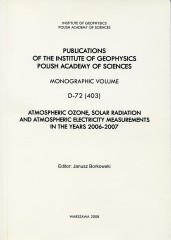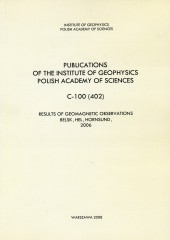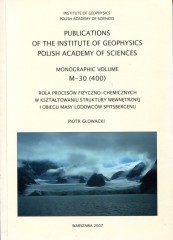BROWSE - VOLUME LIST
- A - Physics of the Earth's Interior
- B - Seismology
-
C - Geomagnetism
C-119, C-118, C-117, C-116, C-115, C-114, C-113, C-112, C-111, C-110, C-109, C-108, C-107, C-106, C-105, C-104, C-103, C-102, C-101, C-100, C-99, C-98, C-97, C-96, C-95, C-94, C-93, C-92, C-91, C-90, C-89, C-88, C-87, C-86, C-85, C-84, C-83, C-82, C-81, C-80, C-79, C-78, C-77, C-76, C-75, C-74, C-73, C-72, C-71, C-70, C-69, C-68, C-67, C-66, C-65, C-64, C-63, C-62, C-61, C-60, C-59, C-58, C-57, C-56, C-55, C-54, C-53, C-52, C-51, C-50, C-49, C-48, C-47, C-46, C-45, C-44, C-43, C-42, C-41, C-40, C-39, C-38, C-37, C-36, C-35, C-33, C-32, C-31, C-30, C-29, C-28, C-27, C-26, C-25, C-24, C-23, C-22, C-21, C-20, C-19, C-18, C-17, C-16, C-15, C-14, C-13, C-12, C-11, C-10, C-9, C-8, C-7, C-6, C-5, C-4, C-3, C-2, C-1
-
D - Physics of the Atmosphere
D-79, D-78, D-77, D-76, D-75, D-74, D-73, D-72, D-71, D-70, D-69, D-68, D-67, D-66, D-65, D-64, D-63, D-62, D-61, D-60, D-59, D-58, D-57, D-56, D-55, D-54, D-53, D-52, D-51, D-50, D-49, D-48, D-47, D-46, D-44, D-45, D-43, D-42, D-41, D-40, D-39, D-38, D-37, D-35, D-34, D-33, D-32, D-31, D-30, D-28, D-27, D-26, D-25, D-24, D-23, D-22, D-21, D-20, D-19, D-18, D-17, D-16, D-15, D-14, D-13, D-12, D-11, D-10, D-9, D-8, D-7, D-6, D-5, D-4, D-3, D-2, D-1
- E - Hydrology
- P - Polar Research
- M - Miscellanea
-
Online First
Browse - Volume list
Numerical Solutions of Two-Dimensional Mass Transport Equation in Flowing Surface Waters
Author(s): Kalinowska M., Rowiński P.
Volume: 404
Series: E-8
Volume: 404
Series: E-8
The problem of water quality receives an increasing attention of the public, politicians, decision makers nowadays. People have to answer how to achieve any given level and pattern of water quality in particular watercourses and also how to mitigate the catastrophes that are inseparable elements of civilization. The EU water framework directive, which came into force at the end of 2000 (Directive, 2000), changes the way of monitoring, assessing and managing water in European countries. Three groups of quality elements (biological, hydromorphological and physico-chemical) have been identified in the water framework directive as necessary to classify the ecological status of a particular water body.
Atmospheric Ozone, Solar Radiation and Atmospheric Electricity Measurements in the Years 2006-2007
Editor(s): Borkowski J.
Volume: 403
Series: D-72
Volume: 403
Series: D-72
The present issue, with subtitle Monographic Volume, is published in place of the former yearbooks entitled: Atmospheric Ozone, Solar Radiation, Belsk and Results of Atmospheric Electricity and Meteorological Observations, S. Kalinowski Geophysical Observatory at Świder.
Results of Geomagnetic Observations; Belsk, Hel, Hornsund, 2006
Editor(s): Jankowski J.
Volume: 402
Series: C-100
Volume: 402
Series: C-100
Poland has three magnetic observatories: Belsk, Hel and Hornsund. Yearbooks for these observatories have been published regularly since 1966 for Belsk and Hel, and since 1978 for Hornsund. During the years, formats of yearbooks have been changing.
Transport Phenomena in Hydraulics
Editor(s): Rowiński P.
Volume: 401
Series: E-7
Volume: 401
Series: E-7
This volume concerns various aspects of research that contributes to the knowledge of a large number of engineering processes and also some natural processes that involve the transformation and transport of momentum, matter and energy. Those problems constitute the basis of the studies performed within the Project of the Ministry of Higher Education and Science Grant No. 2 P04D 026 29; it has also been the basic theme of the 27th International School of Hydraulics held from 18th to 21st September 2007 in Hucisko in the Jura Region in Southern Poland. It has been decided to combine the experience gained by the participants of the meeting and the results achieved within the project to provide the reader with a broad overview of the mentioned problems.
Rola Procesów Fizyczno-Chemicznych w Kształtowaniu Struktury Wewnętrznej i Obiegu Masy Lodowców Spitsbergenu (Role of Physical and Chemical Processes in the Internal Structure Formation and Mass Circulation of Spitsbergen Glacier)
Author(s): Głowacki P.
Volume: 400
Series: M-30
Volume: 400
Series: M-30
W globalnym obiegu wody i energii na Ziemi lodowce spełniają rolę, której nie można pominąć. Chociaż powierzchnia zlodzenia na Ziemi wynosi niespełna 16,3 mln km2 (Szumski, Krenke 1965), co stanowi 11% powierzchni lądów naszego globu, to obszary pokryte lodowcami znacząco oddziaływują nie tylko na tereny przyległe, ale również,co należy podkreślić, na klimat w sensie globalnym. Jednocześnie lodowce podlegają wpływom zmieniającego się klimatu.






